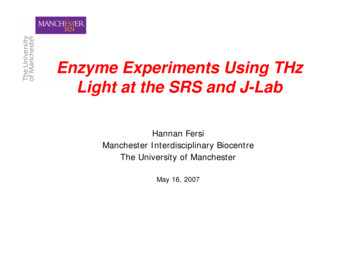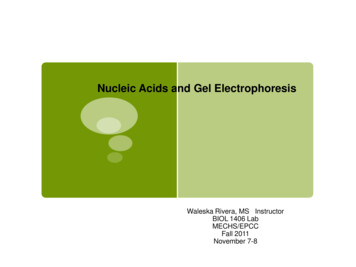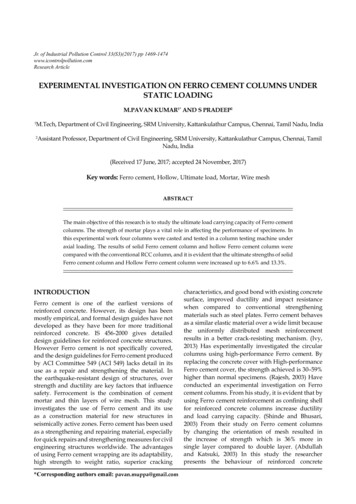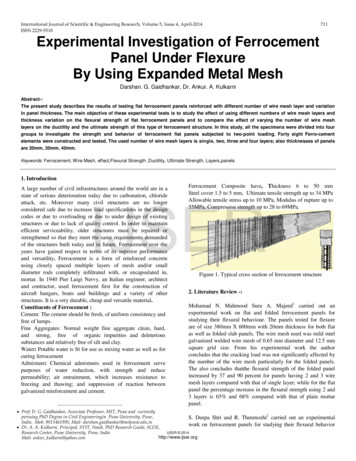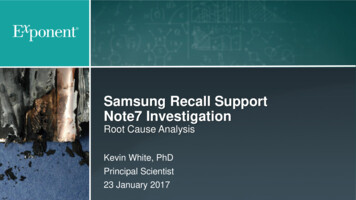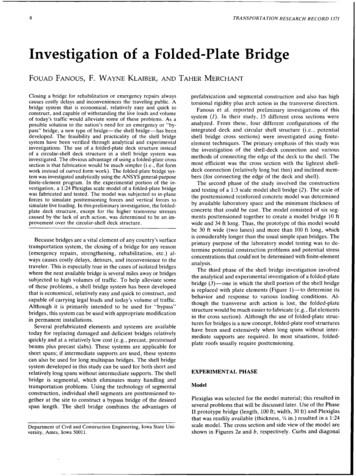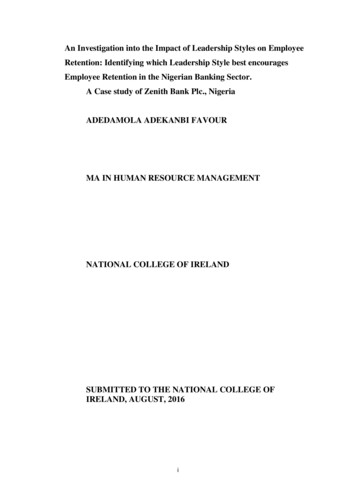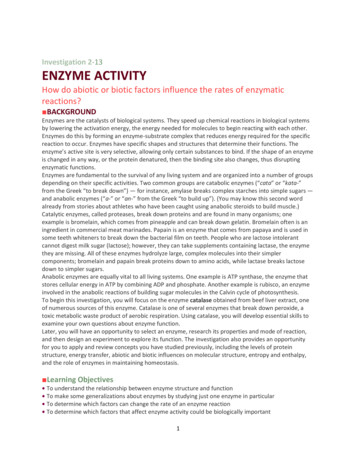
Transcription
Investigation 2-13ENZYME ACTIVITYHow do abiotic or biotic factors influence the rates of enzymaticreactions? BACKGROUNDEnzymes are the catalysts of biological systems. They speed up chemical reactions in biological systemsby lowering the activation energy, the energy needed for molecules to begin reacting with each other.Enzymes do this by forming an enzyme-substrate complex that reduces energy required for the specificreaction to occur. Enzymes have specific shapes and structures that determine their functions. Theenzyme’s active site is very selective, allowing only certain substances to bind. If the shape of an enzymeis changed in any way, or the protein denatured, then the binding site also changes, thus disruptingenzymatic functions.Enzymes are fundamental to the survival of any living system and are organized into a number of groupsdepending on their specific activities. Two common groups are catabolic enzymes (“cata” or “kata-”from the Greek “to break down”) — for instance, amylase breaks complex starches into simple sugars —and anabolic enzymes (“a-” or “an-” from the Greek “to build up”). (You may know this second wordalready from stories about athletes who have been caught using anabolic steroids to build muscle.)Catalytic enzymes, called proteases, break down proteins and are found in many organisms; oneexample is bromelain, which comes from pineapple and can break down gelatin. Bromelain often is aningredient in commercial meat marinades. Papain is an enzyme that comes from papaya and is used insome teeth whiteners to break down the bacterial film on teeth. People who are lactose intolerantcannot digest milk sugar (lactose); however, they can take supplements containing lactase, the enzymethey are missing. All of these enzymes hydrolyze large, complex molecules into their simplercomponents; bromelain and papain break proteins down to amino acids, while lactase breaks lactosedown to simpler sugars.Anabolic enzymes are equally vital to all living systems. One example is ATP synthase, the enzyme thatstores cellular energy in ATP by combining ADP and phosphate. Another example is rubisco, an enzymeinvolved in the anabolic reactions of building sugar molecules in the Calvin cycle of photosynthesis.To begin this investigation, you will focus on the enzyme catalase obtained from beef liver extract, oneof numerous sources of this enzyme. Catalase is one of several enzymes that break down peroxide, atoxic metabolic waste product of aerobic respiration. Using catalase, you will develop essential skills toexamine your own questions about enzyme function.Later, you will have an opportunity to select an enzyme, research its properties and mode of reaction,and then design an experiment to explore its function. The investigation also provides an opportunityfor you to apply and review concepts you have studied previously, including the levels of proteinstructure, energy transfer, abiotic and biotic influences on molecular structure, entropy and enthalpy,and the role of enzymes in maintaining homeostasis. Learning Objectives To understand the relationship between enzyme structure and function To make some generalizations about enzymes by studying just one enzyme in particular To determine which factors can change the rate of an enzyme reaction To determine which factors that affect enzyme activity could be biologically important1
General Safety PrecautionsFollow general laboratory safety procedures. Wear proper footwear, safety goggles or glasses, alaboratory coat, and gloves. Use proper titration techniques, and use pipettes, or syringes. Dispose ofany broken glass in the proper container. Be particularly cautious when using sulfuric acid to denatureyour enzyme! Dispose of all chemicals at the direction of your teacher. When you develop yourindividual investigations you must always consider the toxicity of materials used. Key VocabularyBaseline is a universal term for most chemical reactions. In this investigation the term is used toestablish a standard for a reaction. Thus, when manipulating components of a reaction (in this case,substrate or enzyme), you have a reference to help understand what occurred in the reaction. Thebaseline may vary with different scenarios pertinent to the design of the experiment, such as alteringthe environment in which the reaction occurs. In this scenario, different conditions can be compared,and the effects of changing an environmental variable (e.g., pH) can be determined.Rate of reaction can be determined with a timed decomposition. At various time intervals the reaction ishalted and the amount of substrate remaining is determined by a titration. When you design your ownexperiment, you can compare the change in a reaction, you can infer increase, decrease, or no change inthe rate; this inference is usually called the relative rate of the reaction. THE INVESTIGATIONS Getting StartedFirst, complete this Pearson Lab Bench activity onlinehttp://www.phschool.com/science/biology place/labbench/lab2/intro.htmlAnd Watch this Video 3/19/ap-biology-lab-2enzyme-catalysis.html Part 1: Developing a Method for Measuring Catalase Activity and Determining aBaselinePeroxide (such as hydrogen peroxide) is a toxic byproduct of aerobic metabolism. Catalase is an enzymethat breaks down these peroxides. It is produced by most cells in their peroxisomes. The generalreaction can be depicted as follows:Enzyme Substrate -- Enzyme-Substrate Complex -- Enzyme Product(s) ΔGFor this investigation the specific reaction is as follows:Catalase Hydrogen Peroxide -- Complex -- Catalase Water Oxygen2H2O2 2H2O O2 (gas)Notice that the catalase is present at the start and end of the reaction. Like all catalysts, enzymes arenot consumed by the reactions. To determine the rate of an enzymatic reaction, you must measure achange in the amount of at least one specific substrate or product over time. In decomposition reactionof peroxide by catalase (as noted in the above formula), the easiest molecule to measure wouldprobably be oxygen, a final product. This could be done by measuring the actual volume of oxygen gasreleased or by using an indicator. In this experiment, the amount of hydrogen peroxide (substrate) leftafter the reaction is stopped – not converted to product- can be determined by titrating with potassiumpermanganate (KMnO4).2
General ProcedureIn this experiment the disappearance of the substrate, H2O2, is measured as follows:1. A purified catalase extract is mixed with substrate (H2O2) in a beaker. The enzyme catalyzes theconversion of H2O2 to H2O and O2 (gas).2. Before all the H2O2 is converted to H2O and O2 , the reaction is stopped by adding sulfuric acid (H2SO4).The sulfuric acid lowers the pH, denatures the enzyme, and thereby stops the enzyme's catalytic activity.3. After the reaction is stopped, the amount of substrate (H2O2) remaining in the beaker is measured. Tomeasure this quantity, potassium permanganate is used. Potassium permanganate (KMnO4), in thepresence of H2O2 and H2SO4 reacts as follows:5 H2O2 2 KMnO4 3 H2SO4 -------------- K2SO4 2 MnSO4 8 H2O 5 O2Note that H2O2 is a reactant for this reaction. Once all the H2O2 has reacted, any more KMnO4 added willbe in excess and will not be decomposed. The addition of excess KMnO4 causes the solution to have apermanent pink or brown color. Therefore, the amount of H2O2 remaining is determined by addingKMnO4, until the whole mixture stays a faint pink or brown, permanently. Add no more KMnO4 afterthis point.The setup:3
The Baseline AssayTo determine the amount of H2O2 initially present in a 1.5% solution, one needs to perform all the stepsof the procedure without adding catalase to the reaction mixture. This amount is known as the baselineand is an index of the initial concentration of H2O2 in solution. In any series of experiments, a baselineshould be established first.Procedure for Establishing Baseline1. Put 10 mL of 1.5% H2O2 into a clean beaker.2. Add 1 mL of H2O (instead of enzyme solution).3. Add 10 mL of H2SO4 (1.0 M) Use Extreme care in Handling Acids.4. Mix well by swirling.5.Use a new syringe to remove a 5 mL sample of this mixture. Place this 5 mL sample in another beakerfor “titration”, and assay for the amount of H2O2 as follows: Place the beaker containing the sample overwhite paper. Use a burette to add potassium permanganate a drop at a time to the solution until apersistent pink or brown color is obtained. Remember togently swirl the solution after adding each drop. Record yourdata below.Baseline calculationsFinal Reading of burette mLInitial reading of burette mLBaseline (Final -Initial) mL KMnO4 Part 2: An Enzyme-catalyzed Rate of H2O2 DecompositionBackground: Having done some initial investigations on the action of catalase, you now need to run a“time-course” determination—which will give you a “snapshot” view of how the reaction proceeds overtime. You are going to set up a series of cups, in each of which you will run the same procedure. Theonly difference will be the amount of time you allow the H2O2/catalase reaction to run. You will stop thereaction by adding H2SO4. When you have finished timing and stopping all the reactions, you will run atitration to determine how much H2O2 remains. You will run your Time Course assays at the same time.This is a lot of work, so you need to know what you are doing and be organized! It is possible to get allof this done, but you must work quickly and efficiently—as a team!4
Procedure:1.Label 7 clean cups as follows: 10 seconds, 30 seconds, 60 seconds, 90 seconds, 120 seconds, 180seconds, 360 seconds.2.Fill a beaker with approximately 80 mL of H2SO4. Be careful with H2SO4! If you spill it on your skin,flush with LOTS of water immediately! (This is a dilute sulfuric acid, but it will still burn if you don’tget it off.) Get a 10 mL syringe and reserve it for sulfuric acid. (One group member should be incharge of sulfuric acid.)3.Get another beaker and put approximately 10 mL of catalase into it. Take it back to your desk andkeep it on ice! (This is very important—catalase disintegrates quickly.) Get a 1 mL syringe andreserve it for catalase.4.Get approximately 80 mL of H2O2 in a plastic cup, and then put 10mL in each of the labeled plasticcups.5.Get a stopwatch and figure out how to use it!6.Put 1 mL of catalase in the “10 second” cup. Swirl gently and constantly for 10 seconds. At 10seconds, add 10 mL of H2SO4 , swirl to mix (“alphabet time”), and set the cup aside.7.Put 1 mL of catalase in the “30 second” cup. Swirl gently for 30 seconds. At the end of 30 seconds,add 10 mL of H2SO4, swirl to mix and set the cup aside.8.Repeat #7 for each of the remaining cups, varying the amount of time at which you stop thereaction with H2SO4 . When you have completed the reaction in each of the cups, remove a 5 mlsample and determine the amount of H2O2 present by running a titrationTitration: To determine how much hydrogen peroxide (substrate) has been broken down by catalase atvarying times, measure the amount of peroxide remaining in each sample.To do so, slowly add KMnO4, which is purple, to the sample. The peroxide in the sample causes theKMnO4 to lose color when the solution is mixed thoroughly. When all the peroxide has reacted withKMnO4, any additional KMnO4 will remain light brown or pinkish even after you swirl the mixture. This isthe endpoint. Record the amount of KMnO4 you have used. (The more KMnO4 you use, the moreperoxide is left in the sample.) Note: If you overshoot the endpoint, remove another 5 ml sample andstart over again! Do not discard any of your solutions until your lab is over! You may need a “do-over”.9.As you determine each value, enter it in Table 2.1.10. Graph the Amount of H2O2 Decomposed by Catalase Over Time. Identify it as Graph 2.1. Don’tforget that you need to title your graph and label your axes appropriately. You can download anExcel version on the website.11. Complete the Analysis of Results. Attach your answers.12. Be prepared to discuss your results with the class tomorrow (and maybe take a quiz?)5
Table 2.1 “Time-course” Determination of Catalase Activitytime(sec)10306090120180360A. BaselineB. Initial ReadingKMnO4 (mL)C. Final ReadingKMnO4 (mL)D. Amount of KMnO4Used (difference betweenB and C)E. Proportional Amountof H2O2 UsedA minus DRecord the baseline value obtained in Exercise 2B in all boxes on line A, above.*Remember that the baseline tells how much H2O2 was in the initial 5-mL sample. The difference between theinitial and final readings tells how much H2O2 was left after the enzyme-catalyzed reaction. The shorter thereaction time, the more H2O2 remained and therefore the more KMnO 4 was used in titrating.Analysis of Results1. Consider the line you have drawn on Graph 2.1. What does this line represent?2. What does Graph 2.1 tell you about the rate of the reaction over time?We can calculate the rate of a reaction by measuring, over time, either the disappearance of substrateor the appearance of product. Reaction rate E2 – E1t2 – t13. Using the formula above for rate ( y/ x), determine the initial rate of the reaction and rates betweeneach of the time points in your procedure and record them in Table 2.2. Show your math below:Table 2.2 Rate DeterminationTime Intervals(sec)0 – 1010 – 3030-6060-90Rate (mL/sec)690-120120-180180-360
4. What is meant by Vmax in an enzymatic reaction? Mark it on your graph.5. When is the rate the highest? Why is it highest here?6. When is the rate the lowest? Why is it lowest here?7. What was the inhibiting effect of sulfuric acid on this reaction? What did the sulfuric acid do to theenzyme?8. What was the purpose of establishing a baseline?9. Why, when establishing the baseline, are you asked to add 1 mL of water? Why add 10 mL of sulfuricacid to your peroxide samples if there was no catalase to denature? Please
) in a beaker. The enzyme catalyzes the conversion of H 2 O 2 to H 2 O and O 2 (gas). 2. Before all the H 2 O 2 is converted to H 2 O and O 2 , the reaction is stopped by adding sulfuric acid (H 2 SO 4). The sulfuric acid lowers the pH, denatures the enzyme, and thereby stops the enzyme's catalytic activity. 3. After the reaction is stopped, the amount of substrate (H 2 O 2


